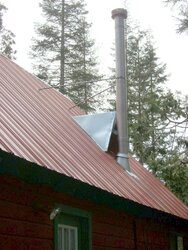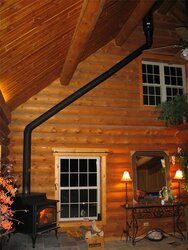Can 45 degree DW pipe work?
- Thread starter Tavery
- Start date
-
Active since 1995, Hearth.com is THE place on the internet for free information and advice about wood stoves, pellet stoves and other energy saving equipment.
We strive to provide opinions, articles, discussions and history related to Hearth Products and in a more general sense, energy issues.
We promote the EFFICIENT, RESPONSIBLE, CLEAN and SAFE use of all fuels, whether renewable or fossil.
You are using an out of date browser. It may not display this or other websites correctly.
You should upgrade or use an alternative browser.
You should upgrade or use an alternative browser.
- Status
- Not open for further replies.
It may work, but I wouldn't try to run MY connector pipe
that far without some additional support(s) in the angled run.
If that were a Class A chimney system, with 15 or 30 degree offsets,
it would require plumbing strap or something similar coming off
the underside of the ceiling, (probably every 5 feet (or less), & zipscrewed
to the connector...
Those supports may not look aesthetically pleasing, but they'll be safe.
that far without some additional support(s) in the angled run.
If that were a Class A chimney system, with 15 or 30 degree offsets,
it would require plumbing strap or something similar coming off
the underside of the ceiling, (probably every 5 feet (or less), & zipscrewed
to the connector...
Those supports may not look aesthetically pleasing, but they'll be safe.
My thoughts as well when I saw this Daksy, if we Go this route will definitely support mid span.
Should have included the fact that
Some perhaps have ( I have) but, really don't see that as a regular thing one would want to achieve to service a chimney cap.
Should have included the fact that
- This is intended to be 24/7 primary home heat source.
- Lots of oak / hickory / ash cord wood available.
- The corner install is a must
- Alternative to this has/is been considered, ( 12 inch offset / 9 ft. stove pipe / 12 foot of chimney pipe above the 12:12 roof.)
Some perhaps have ( I have) but, really don't see that as a regular thing one would want to achieve to service a chimney cap.
I can never get over my WTH?! reaction when I first saw that installation. It has to be a creosote generator. There's no reason why that stove couldn't and shouldn't have been moved to the right where that side table and mirror are. Look at your home layout critically and think about moving the stove closer to center even if it takes a little redecorating. Once installed and burning you are going to want it to be a focal point of the room.
Last edited:
oconnor
Minister of Fire
Why not consider running class A pipe for most of the run instead of connector pipe? Or even use pre insulated double wall chimney liner.
While not a usual use for the insulated liner lengths, they would retain more heat and be less likely to creosote up.
Moving the stove to allow a straighter run up and extending the Class A chimney lower below the ceiling would still be the best choice.
While not a usual use for the insulated liner lengths, they would retain more heat and be less likely to creosote up.
Moving the stove to allow a straighter run up and extending the Class A chimney lower below the ceiling would still be the best choice.
Why not consider running class A pipe for most of the run instead of connector pipe? Or even use pre insulated double wall chimney liner.
While not a usual use for the insulated liner lengths, they would retain more heat and be less likely to creosote up.
Moving the stove to allow a straighter run up and extending the Class A chimney lower below the ceiling would still be the best choice.
With a 12/12 pitch he'd need a 45 in the Class A system. That's not to code in the US, if you could even GET one.
For a corner install, I'd run straight up. It'll require 12' of Class A ABOVE the roof & a couple of roof brace kits,
but it'll function optimally. The downsides are the sweeping would have to be done from the inside, unless you
had a manlift, it'll look like an unexploded SCUD on the outside & the cost of the Class A.
why is 45 not o code in us we get them and use them occasionally. I am not aware of any code issue and neither are our inspectors. also at least from olimpia you can now get powder coated class a which looks much better. I do agree I would avoid that setup if at all possible.
oconnor
Minister of Fire
Good point Daksy - Not so much a code issue if I recall as it is that the manufacturers don't permit them in the instructions. In Canada the 30 degree units are only allowed in internal installs.
Last edited:
spendaviscpa
Member
My situation was similar. I have a 12/12 roof at my cabin. I never considered running the double wall stove pipe up the ceiling with 45 degree joints. I have seen that picture the OP posted and have always wondered how well it worked. In planning my installation, I was mortified of having 14 feet of Class A pipe coming out of the roof. I debated for some time about putting the stove in a different location. At the end of the day, I couldn’t find a better place to put the stove. So I opted for the missile silo. I don’t think it looks that bad or as bad as I was expecting. I do feel good that I meet the 10-2-3 requirement. I did pay to have the chimney installed by a professional. I see many chimneys that only come out 2 or 3 feet on the low end of a very step roof. It makes me wonder what kind of stove they are running and if they have any draft issues. My recommendation is to find another location for the stove if you don’t like the look of a missile silo. Good Luck!

oconnor
Minister of Fire
why is 45 not o code in us we get them and use them occasionally. I am not aware of any code issue and neither are our inspectors. also at least from olimpia you can now get powder coated class a which looks much better. I do agree I would avoid that setup if at all possible.
Here's a better answer than my previous one. According to M+G Duratech, offsets of greater than 30 degrees are not permitted by the UL 103 standard. In their install instructions the specifically mention not using a 30 and 15 to make a 45 degree unit.
Here's a link to their instructions http://www.duravent.com/Product.aspx?hProduct=1
If their statement on UL 103 is correct, that would explain the lack of 45 degree class A products. I looked at Olympia's page and didn't see any there.
Update - here is the UL 103 section that prohibits the over 30 degree bend
http://ulstandardsinfonet.ul.com/scopes/scopes.asp?fn=0103.html
1 Scope
1.1 These requirements cover factory-built chimneys intended for venting gas, liquid, and solid-fuel fired residential-type appliances and building heating appliances in which the maximum continuous flue-gas outlet temperatures do not exceed 1000°F (538°C). Factory-built chimneys are intended for installation in accordance with the Standard for Chimneys, Fireplaces, Vents, and Solid-Fuel Burning Appliances, NFPA 211, and in accordance with codes such as the International Mechanical Code, the International Residential Code, and the Uniform Mechanical Code. They are intended for installation inside or outside of buildings or both, in a manner that provides a vertical (30 degree maximum offset) conduit or passageway to transport flue gases to the outside.
Warm_in_NH
Minister of Fire
IF its an exterior gable wall why wouldn't you go out through the wall to a clean out T then straight up with class A? Looks?
I was also told by one stove shop, the one I didn't buy my pipe from, that any stove pipe inside needs to have a non combustible surface under it. Didn't make much sense then or now though.
I was also told by one stove shop, the one I didn't buy my pipe from, that any stove pipe inside needs to have a non combustible surface under it. Didn't make much sense then or now though.
Re; The comments about maximum degree of offset. Would this not eliminate all the 90 degree elbows required to go through the wall to an outside chimney?
I am not sure how one remedies this apparent contradiction in application.
Any ideas?
I am not sure how one remedies this apparent contradiction in application.
Any ideas?
Re; The comments about maximum degree of offset. Would this not eliminate all the 90 degree elbows required to go through the wall to an outside chimney?
I am not sure how one remedies this apparent contradiction in application.
Any ideas?
That would require a tee, with a cleanout.
That would require a tee, with a cleanout.
So, the 30 degree limitation is only for Class A chimney sections?
I am assuming this is what begreen means to indicate regarding the clean out tee. I get that for sure.
I was thinking of the connector pipe such as standard black Double Wall (DW) on the interior.
If this install could be changed (because of existing window locations) straight up 8 feet/ 45 degree for 7.5 feet/ 45 straight up again into 6 feet of class A.
would anybody be in strong opposition to that?
Correct. The restriction for offset angle applies to chimney pipe (class A) not to connector pipe.
What you've described is not ideal, but it sounds kosher as long as the connector is all in the room and doesn't penetrate a wall or ceiling. I'd definitely recommend using double-wall connector for the install. Pics always help.
What you've described is not ideal, but it sounds kosher as long as the connector is all in the room and doesn't penetrate a wall or ceiling. I'd definitely recommend using double-wall connector for the install. Pics always help.
CenterTree
Minister of Fire
I can never get over my WTH?! reaction when I first saw that installation. It has to be a creosote generator. There's no reason why that stove couldn't and shouldn't have been moved to the right where that side table and mirror are. ...
They couldn't move it, there's a magazine on the floor right there.

.
This is a VERY strange setup though. WoW!
Last edited by a moderator:
scooby074
Feeling the Heat
Holy Mother of Pipe!
What a strange setup in the OP. It looks completely self supporting! That's a whole lot of horizontal run for little sheet metal screws to hold up. Cleaning would likely be a nightmare... Creosote?
Id definitely go directly under the chimney in a straight run. Still a heck of a run for connector though, but at least it would be all vertical.
What a strange setup in the OP. It looks completely self supporting! That's a whole lot of horizontal run for little sheet metal screws to hold up. Cleaning would likely be a nightmare... Creosote?
Id definitely go directly under the chimney in a straight run. Still a heck of a run for connector though, but at least it would be all vertical.
- Status
- Not open for further replies.
Similar threads
- Replies
- 18
- Views
- 1K
- Replies
- 23
- Views
- 4K
- Replies
- 12
- Views
- 474
- Replies
- 20
- Views
- 736


